How to wear and use a helmet?
It took a long time for helmet to became common in cycling, and it'll became justified. Most of cyclists use it every-time they ride on their bike. And what about roller? Why is it no more used? How to choose it? How much money have I to invest in? Here are some answers to this questions... Wearing a helmet pros or cons?
Par alfathor
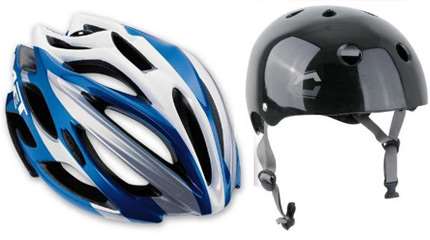
The law ans the helmet
In France, the helmet is optional for cyclist. In 2002 an advertisement said: « In bike the helmet isn’t compulsory, it’s simply indispensable ». For roller-skating there is no law about helmet except during competitions and privates events (in agreement with organisers). You have to inform yourself about the legislation in your country.
Disparity of risks in accordance with age
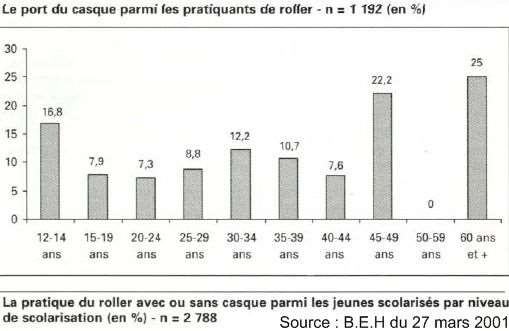 Most of skaters are between 12-14 years old. It’s the hinge age in which there is the most of accidents too (48,5% of accidents happen to the 10-14 years), simply because their learning and propulsive capacities aren’t completely developed. On the other hand, children are skaters who use the most the helmet because parents are worry about their children. The practice of roller-skating decrease with the age. Men use more the helmet than women (14,4% against 8,8%). It seem men have more accidents too (64,1% against 35,9%).
Most of skaters are between 12-14 years old. It’s the hinge age in which there is the most of accidents too (48,5% of accidents happen to the 10-14 years), simply because their learning and propulsive capacities aren’t completely developed. On the other hand, children are skaters who use the most the helmet because parents are worry about their children. The practice of roller-skating decrease with the age. Men use more the helmet than women (14,4% against 8,8%). It seem men have more accidents too (64,1% against 35,9%).
The use of the helmet depends essentially of the practice you envisage.
In cycling, the most expose to injuries are the teenagers and young adults whose spirit are linked to freedom, thoughtlessness and risk. We can suppose it’s the same for roller-skaters.
How to determine your size?
Like for cloths, there is different sizes. Manufacturers use the diameter of the head to standardize their products. Most of the time, helmets are adjustable and can be used for several sizes (52/57, 54/57 (M) or 58/60 (L) for example). You can measures your head size with a string or a tape measure which have to take place 2cm over the eyebrows (where the head is the largest). It must be placed overs the ears and be all around the head.
What is the good pattern?
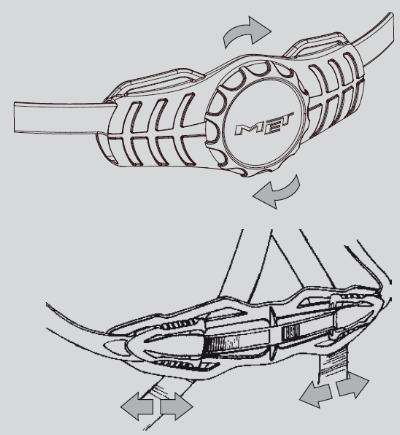 The prize isn’t every-thing. Last year a helmet from a specialized supermarket was elected the safest of its class.
The prize isn’t every-thing. Last year a helmet from a specialized supermarket was elected the safest of its class.
Choose a helmet need as patience as too choose your rollers. It isn’t enough taking one in a shop to have an adapted and efficient helmet.
Generally, down-market products haven’t micro-metric adjustment, they can be efficient but not enough precise. Middle market helmets have occipital adjustment which permit to adjust it on the back of the head. Some have to roll to have a better adjustment. Helmets with notches are very efficient too.
Here are some criteria to choose:
- touch the joining between plastic and foam rubber: if they aren’t sealed or if they are independent forget it. Generally less you feel the joining, better is the finishing.
- Wear a helmet at you size. Even if it isn’t fastened, it must not slide on the front, on the rear or on the side of the head. If it move it won’t protect you.
- If it had a good conception, you’ll just have to adjust it without fasten it and it won’t move. Check your head if the helmet stay on it’s okay.

How to fasten your helmet?
- Adjust the straps in order to tighten them and to put the helmet flat, not to the front, not to the rear. The straps must go under the rear.
- Adjust the chin strap, the buckle mustn’t press the jaw. The helmet is efficient only if the straps are fastened what’s restricting.
- Take care on adjusting the strap on the rear, the helmet mustn’t move but it mustn’t press the head.
The characteristics of an helmet are depend of the use.
What helmet for what practice?
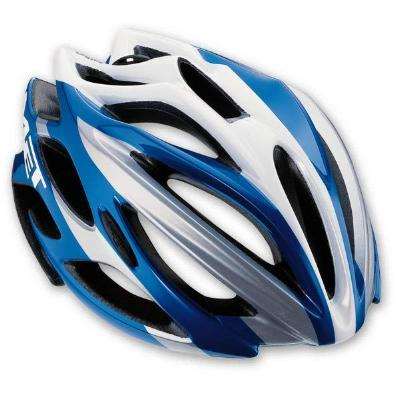 Each practice need a particular material…
Each practice need a particular material…
Ride and speed helmet
They are the same than cycling helmets. They are often light and airy in order to evacuate the perspiration during efforts. Some famous brands contest the market to each other: Met, Giro, Bell…The prices vary in accordance with the finishing and the brand. 30 Euros to 40 Euros for a good helmet bottom of the range. The prices grow if straps are made with Kevlar and are function of the number of airing and of the weight.
Prices: 20 to 250 Euros
Street, stunt and half pipe helmets
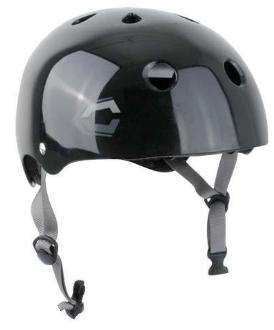 Bowl-shaped, they come down to the rear of the head in order to protect the cervical. Many riders are mistaken and don’t use helmet or don’t fasten it during contest: so it’s absolutely useless. It’s compulsory during competitions, but it’ll take time to change mind in « street » where the « no-pads » spirit made a lot of damage. A street helmet is nearly 30 Euros. There is only some shapes. The main differences are decoration and comfort. Try it, heads are different.
Bowl-shaped, they come down to the rear of the head in order to protect the cervical. Many riders are mistaken and don’t use helmet or don’t fasten it during contest: so it’s absolutely useless. It’s compulsory during competitions, but it’ll take time to change mind in « street » where the « no-pads » spirit made a lot of damage. A street helmet is nearly 30 Euros. There is only some shapes. The main differences are decoration and comfort. Try it, heads are different.
Prices:20 to 50 Euros 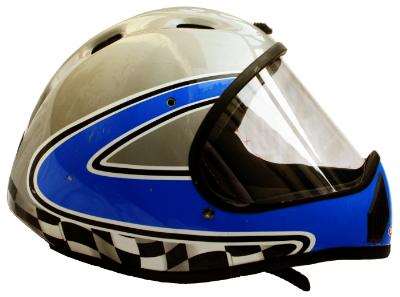
Downhill helmets
Most of riders use full-face helmets like BMX helmets. They are more protectives for the face and they con have a visor which protect from mosquitoes. Some riders use shaped-helmet but it may injuries to cervical if the back is too rigid and don’t crush on the ground. More, shaped helmets aren’t as safe as they could because its main goal is to improve the penetration in the air.
Prices: 50 to 250 Euros
Conclusion
It’s understood, to choose a good helmet need time and a minimal budget. Head injuries are only 5% of roller-skating trauma but they can be very more serious than the others.
Lastly, roller-protection aren’t only the helmet, wrist-guards are very recommender to avoid arm-injuries. Don’t hesitate to learn how to fall too, it’s the best protection.
* Bulletin Epidémiologique Hebdomadaire (BEH) – 27 march 2001
Links
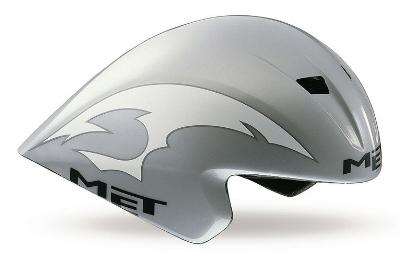 Met helmets
Met helmets
Bulletin épidémiologique sur le roller et le port du casque (2,84 Mo – format pdf)
Dossier sur le port du casque chez les cyclistes
Translation: Nabucau
Photos: Hawaii Surf, Met
& all rights reserved
